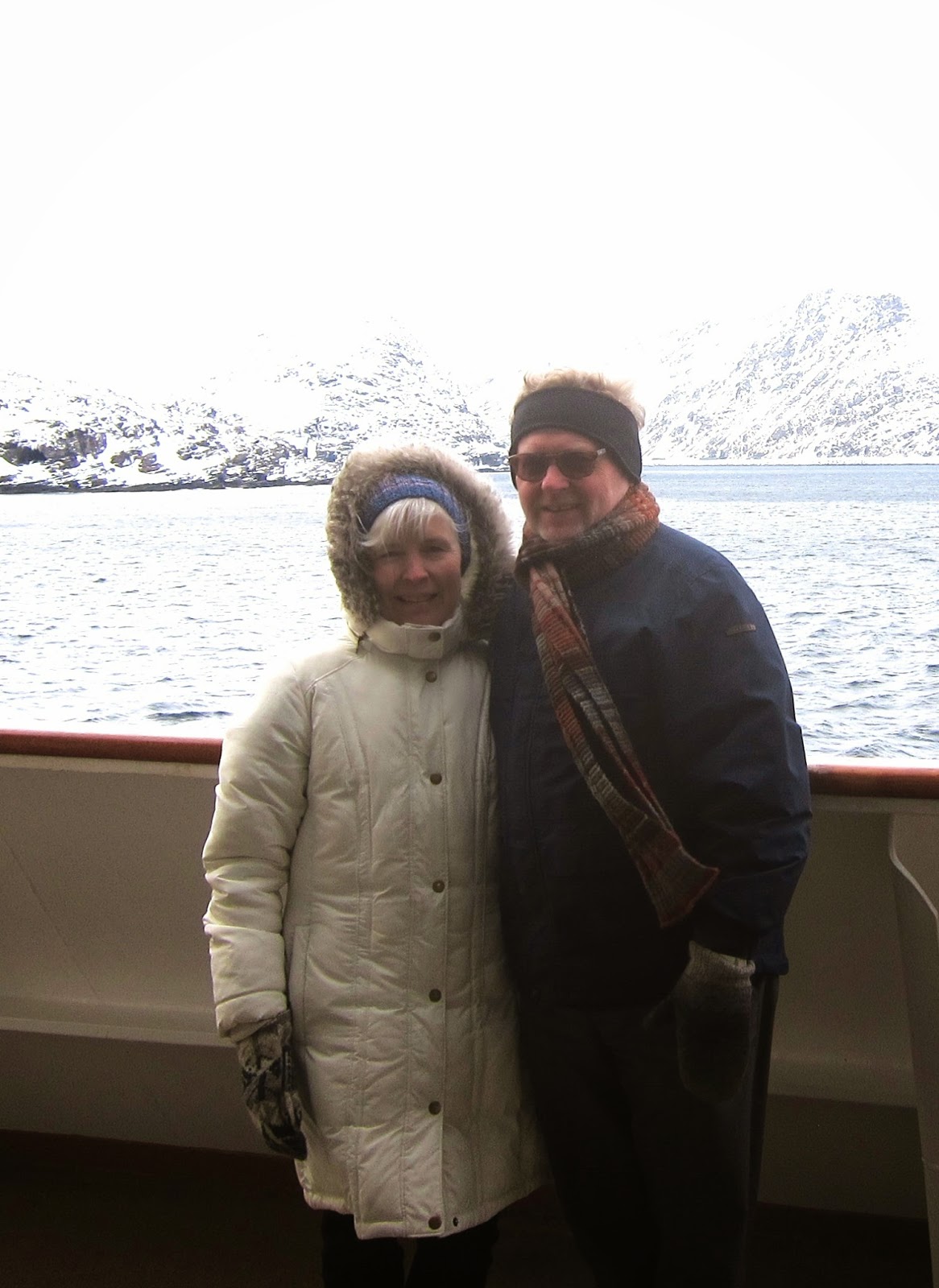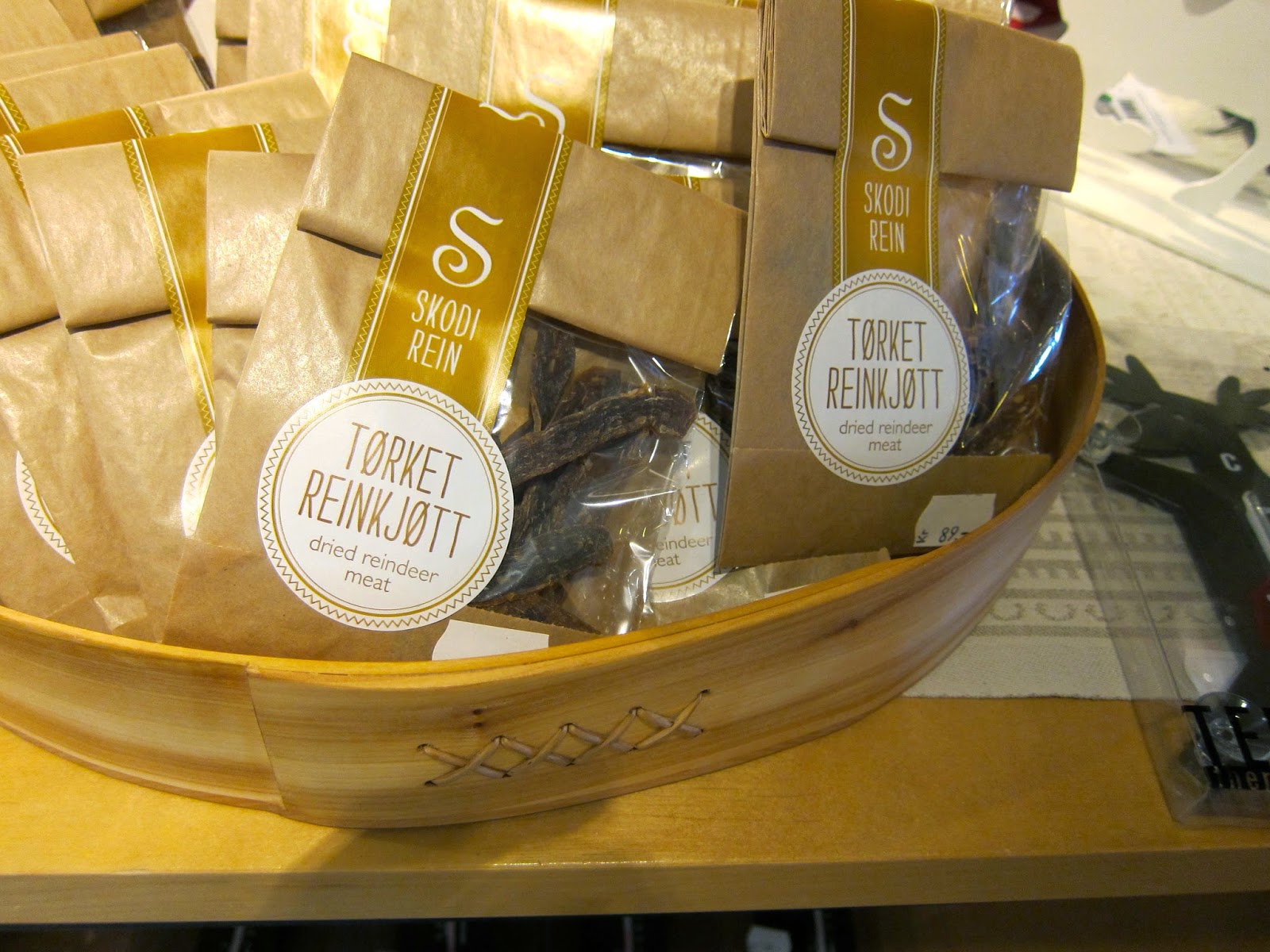After a two-hour flight from Oslo, we began the descent into Tromsø. What a beautiful location! The city is located mostly on an island between the mainland and another island further west. It's surrounded by mountains and water. Even though it's above the Arctic Circle, the average temperatures vary between 20 and 60 degrees F, with extremes rarely below 9 or above 69 degrees F (that's minus 7 - 16 C, with extremes rarely below minus 15 C and 21 C). It's that Gulf Stream activity again that keeps it temperate. Temperatures inland are much colder.
We were scheduled to make this trip a month ago, but had to reschedule because of an airline strike. Unfortunately, our Tromsø friends Liv and Vinjar had plans to be out of town when we were able to reschedule; however, thanks to their hospitality in absentia, we had a wonderful place to stay with great views toward the mainland mountains. Thank you, Vinjar and Liv.

Trees are not seen often this far north. Several islands we passed had windmill farms for generating power. The perfect environment to make it worthwhile.
The North Cape area has several parts: the King Oscar monument, the globe at the most northern point, the Children of the Earth monument, and the Visitors Centre which is built down into the cliff rather than up, because of the strong winds.
These are views from the North Cape area. I believe the point in the distance is the true northernmost land, though both the North Cape and it are debatable because they are islands.
In the gift shop you can buy dried reindeer meat.
King Olav V inscribed his name on this stone here in 1988.
The visitor's centre has this beautiful, small Christian chapel (St. John's Chapel) for reflection and meditation.
And finally, the Children of the Earth monument. What a great idea!
And finally, our last port-of-call, Kirkenes.
We were scheduled to make this trip a month ago, but had to reschedule because of an airline strike. Unfortunately, our Tromsø friends Liv and Vinjar had plans to be out of town when we were able to reschedule; however, thanks to their hospitality in absentia, we had a wonderful place to stay with great views toward the mainland mountains. Thank you, Vinjar and Liv.
Thank you also to our friend and my former student. Anneli and her husband Andrew and their sweet daughter, Lilian for a delicious lunch, interesting conversation, and walk in the snow Saturday afternoon.
We learned there are five ski jumps in town. This one was along our walking path.
Here's what you see as you come down the jump -- buildings of the University of Tromsø.
One of the landmarks Tromso is known for is the Arctic Cathedral designed by Jan Inge Hovig. It's prominently located on the mainland just across the bridge from the main part of Tromsø.

When you go from the airport to the city center, you drive through a system of long tunnels, including a number of roundabouts. There is also underground parking for the city. All this saves on snow-clearing on the roads since there's snow a major part of the year. I think Norwegians would rather go through or under mountains than over them.
The next three pictures were taken from the mainland looking over towards the main part of town. We had hoped to take a cable car up a mountain which is said to give a wonderful panoramic view; however, the cars were not running because of dangerous high winds. In the second photo you can see the snow drifting on the mountain because of the winds.
We took a drive out of the city south along the mainland shore. The mountains you see are on the islands between the mainland of Norway and the ocean.
This farm house and shed have sod roofs.
Soon it was time to board our ship, the Midnatsol -- Midnight Sun -- for our trip north. Here's the view out our cabin window as we wait to leave Tromsø. The Arctic Cathedral is just left of center.
The Hurtigruten ships sail from Bergen to Kirkenes constantly. It's an 11-day voyage to do a round trip. Our trip was to extend over parts of three days -- leaving the afternoon/evening of the first day, and arriving in the morning of the third day. Here's one of the sister ships on its way down the coast. Ours was a newer ship and had much better viewing windows at the front on the 8th and 9th decks.
Trees are not seen often this far north. Several islands we passed had windmill farms for generating power. The perfect environment to make it worthwhile.
Seemingly out of nowhere, we'd see a small collection of houses near the water's edge. Hardy people,indeed. I'm not sure all these communities are reachable any other way than by boat.
The ship stops occasionally at small fishing villages to pick up cargo or to take on or let off a passenger. Here we've stopped at Havøysund. I like the look of the brightly colored houses against the snow and rock.
We were fortunate to be on the the 6th deck (of 9) that had a walking loop clear around the outside edge of the ship. It provided us with some refreshing exercise in the clean air as well as wonderful views of the passing scenery. When the winds were high, it was hard to keep your balance; but most of the time it was not nearly as cold as winter at home in Michigan.
On the island of Magerøya, along with many other passengers, I took an excursion to Nordcapp -- North Cape, said to be the northernmost point in Europe (though the actual northernmost point is next to this promontory but more difficult to reach). At this point, one is closer to the North Pole than to Oslo. We travelled 45 minutes by bus up to the summit of a steep cliff that drops down 307 meters to the Barents Sea, part of the Arctic Ocean. On the way, we had a wonderful guide who told us all sorts of fascinating facts about the region. For example, in the summer there is a wild orchid that grows on the island and during the spring and summer several thousand reindeer belonging to five Sami families graze there.
Notice the snow fences protecting the buildings from potential avalanche damage.
The North Cape area has several parts: the King Oscar monument, the globe at the most northern point, the Children of the Earth monument, and the Visitors Centre which is built down into the cliff rather than up, because of the strong winds.
King Oscar II in 1873 had this monument erected and he stated at its unveiling, "Not as a transitory adornment, but as a solemn sign that the kingdom of Norway reaches hither, therefore I have erected this monument at the outermost point of the North."
These are views from the North Cape area. I believe the point in the distance is the true northernmost land, though both the North Cape and it are debatable because they are islands.
This globe structure is on the North Cape cliff.
Believe me, the winds were strong and my hood needed holding to stay on.
In the gift shop you can buy dried reindeer meat.
King Olav V inscribed his name on this stone here in 1988.
The visitor's centre has this beautiful, small Christian chapel (St. John's Chapel) for reflection and meditation.
And finally, the Children of the Earth monument. What a great idea!
On the way back, we passed cod fish drying on racks in the old-fashioned way.
This is the town of Honningsvåg, from which we took the bus to the North Cape.
At one of our stops, a crab fisherman came on board to show the passengers the enormous King Crab.
Another village stop; this time Kjøllefjord.
This church-shaped monument -- Finnkirka -- is just before the harbor to the town and is supposedly an ancient Sami ceremonial site.
Here's a view of part of the front-of-the-boat lounge on the top deck.
One of the earliest "tourists" to the North Cape was Francesco Negri, an Italian priest and scientist who visited there in 1664. He wrote in his Viaggio settentrionale, "Here I am now at North Cape, at the furthest tip of Finnmark. At the very end of the world. Here, where the world ends, so ends my curiosity. And I can go home satisfied, if God will." Except for the part about curiosity, he sums up my feelings pretty well.
The next post will move to warmer climes. I'll be sharing about my spur-of-the-moment, 11-day trip to the north of Vietnam a few weeks back. What an amazing place!


































































No comments:
Post a Comment